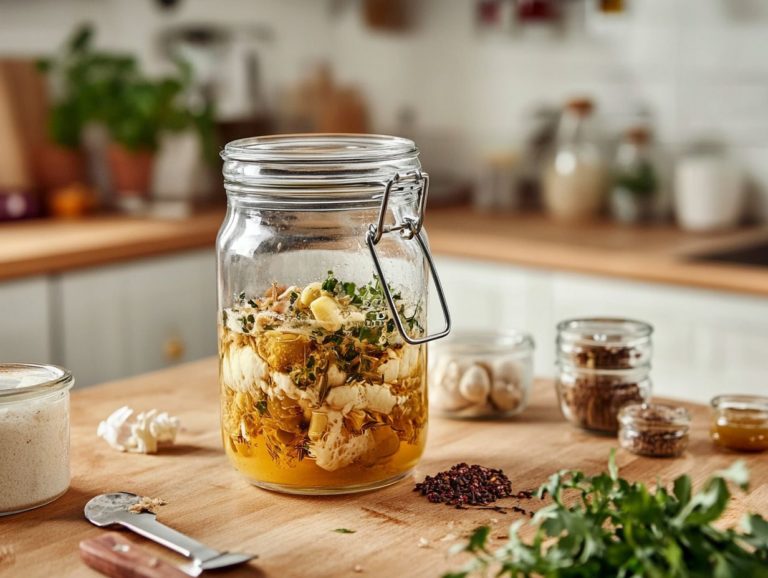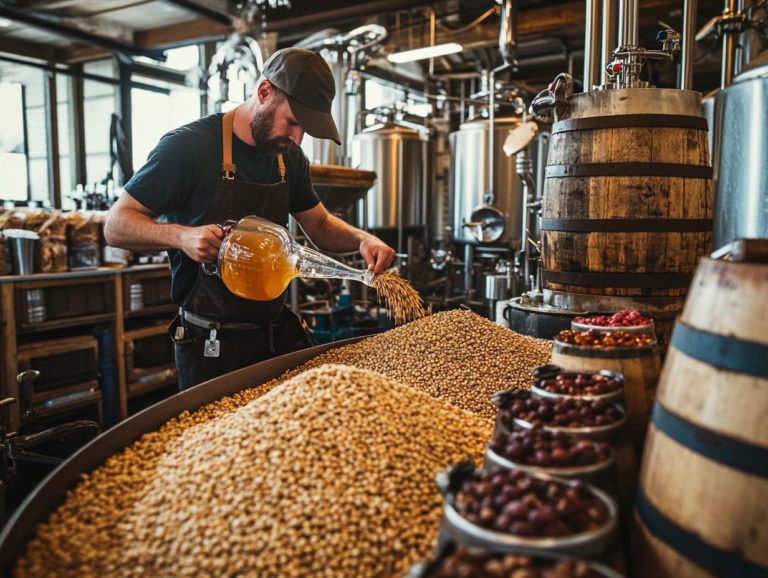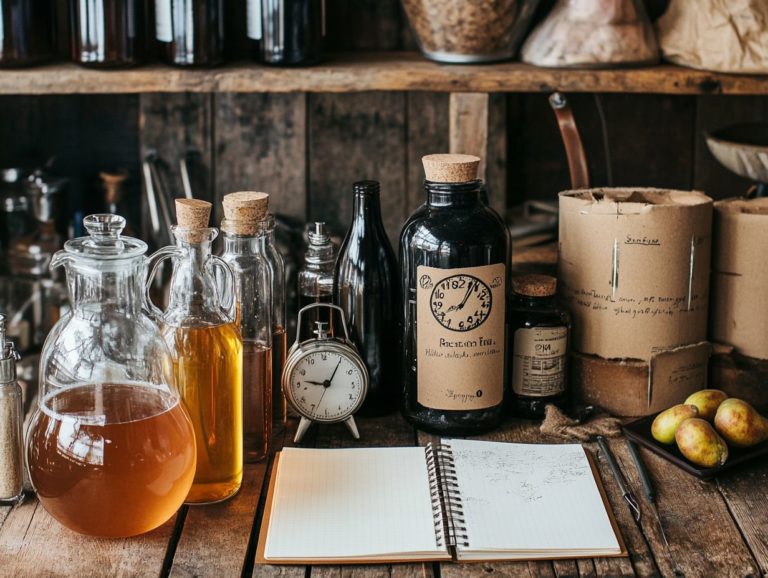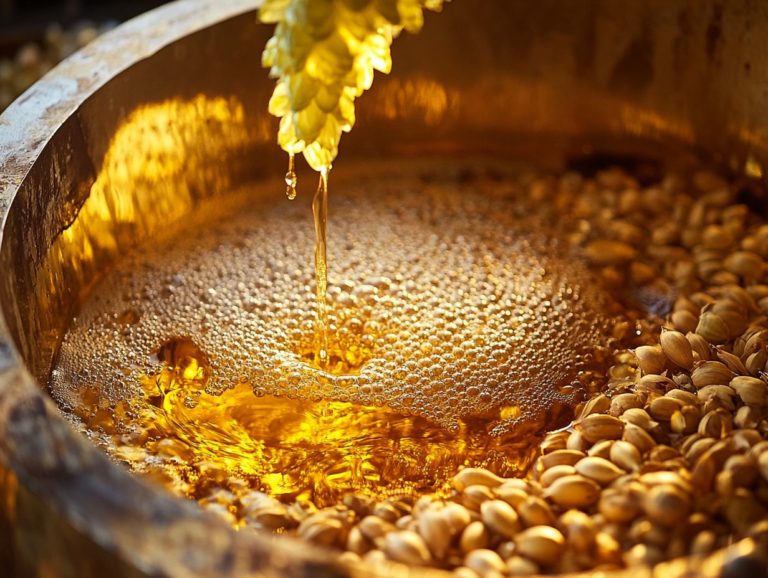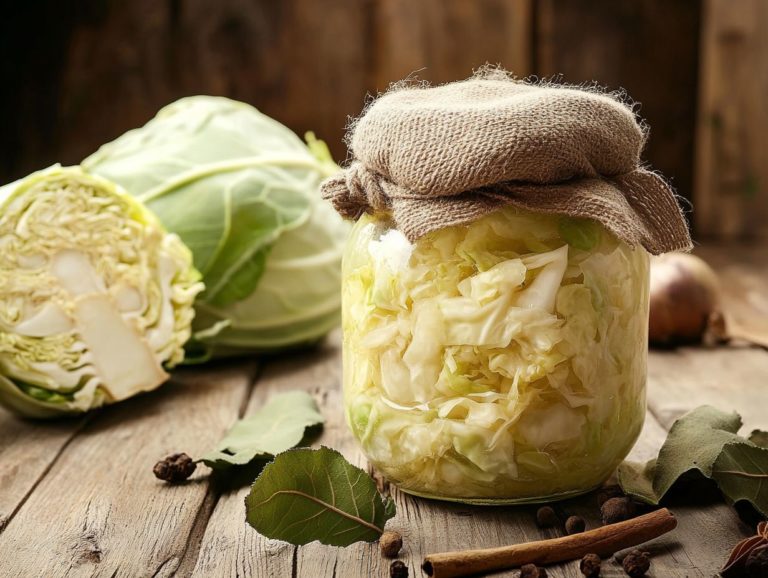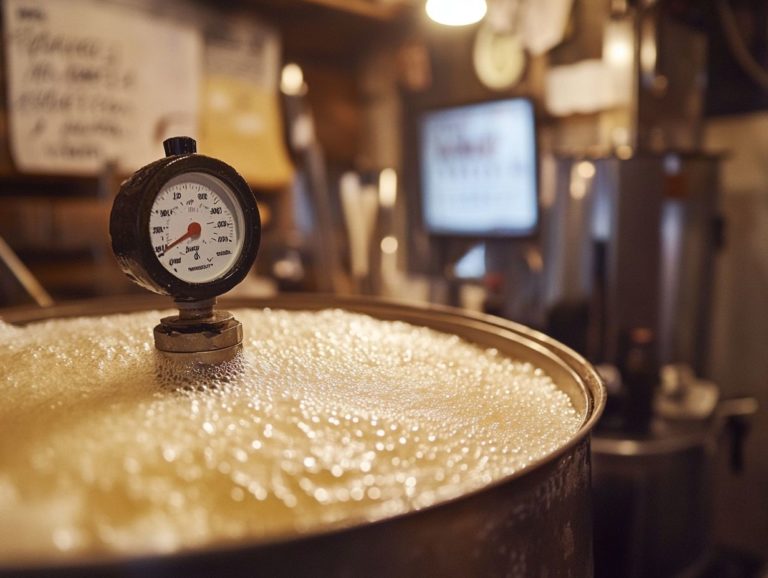Understanding the Fermentation Cycle in Brewing
Fermentation is an intriguing and vital process in brewing that transforms basic ingredients into the rich flavors and aromas you savor in your favorite beer. This natural phenomenon is integral to beer fermentation, encompassing various stages and yielding unique beer profiles.
This article delves into the intricate world of fermentation, shedding light on the indispensable role of yeast, the ingredients that come together in brewing, and the various stages of the fermentation cycle, including primary and secondary fermentation.
Discover key factors that influence fermentation now, such as temperature control and yeast selection, explore common challenges brewers encounter, and learn how to achieve the best results.
Whether you re just starting your journey as a homebrewer or you re a seasoned aficionado, you ll uncover valuable insights to elevate your brewing experience by understanding the nuances of fermentation science and brewing techniques.
Contents
- Key Takeaways:
- What is Fermentation?
- The Brewing Process
- Conclusion
- The Fermentation Cycle
- Factors Affecting the Fermentation Cycle
- How Does the Type of Yeast Affect the Fermentation Cycle?
- What is the Role of Oxygen in Fermentation?
- Common Issues in the Fermentation Cycle
- What Causes Stuck Fermentation?
- What is Off-Flavor in Fermented Beer?
- How to Prevent Contamination in the Fermentation Process?
- Frequently Asked Questions
- What is the fermentation cycle in brewing?
- How does yeast (such as Saccharomyces cerevisiae) play a role in the fermentation cycle?
- What are the fermentation stages in the fermentation cycle?
- How long does the fermentation cycle typically last in brewing practices?
- What is the ideal fermentation temperature for brewing different types of ales and lagers?
- What happens if fermentation conditions are not met during the fermentation cycle?
Key Takeaways:
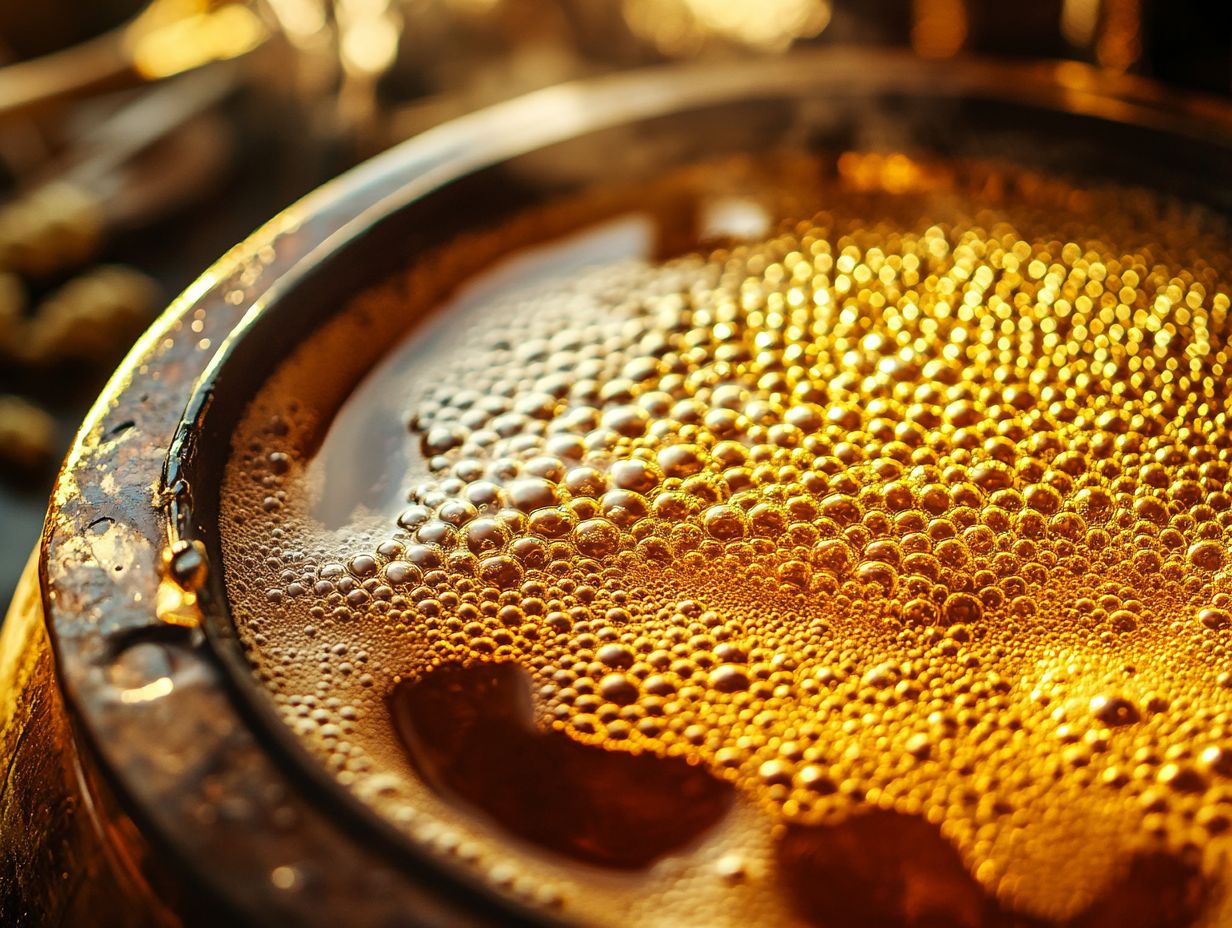
- Fermentation is a crucial process in brewing that converts maltose sugars into alcohol and carbon dioxide, giving beer its unique flavor and texture.
- Yeast plays a key role in fermentation by consuming sugars and producing alcohol and carbon dioxide. Different strains of yeast can impact the flavor and aroma of beer.
- The fermentation cycle consists of primary, secondary, and conditioning stages, each with their own specific roles in developing the final product, ensuring its quality, and monitoring how sugars convert into alcohol.
What is Fermentation?
Fermentation is an intricate biochemical process that converts sugars into alcohol and carbon dioxide, primarily driven by yeast. This process is essential in beer production, where various yeast strains, including those used for ale and lager fermentation, are instrumental in shaping the final characteristics of the beverage.
The dynamics of fermentation involve several stages, including active and stationary phases. It is imperative to monitor fermentation conditions meticulously, including fermentation temperatures, to achieve the desired flavor profiles and alcohol content.
What is the Role of Yeast in Fermentation?
Yeast is essential in the fermentation process, serving as the primary microorganism that transforms the sugar-rich liquid extracted from grains during brewing into alcohol and carbon dioxide during beer production. Different yeast strains, such as ale yeasts and those used in lager fermentation, play a significant role in this transformation.
Each yeast strain contributes distinct flavors and aromas to the final product, profoundly shaping the beer’s character. For example, Saccharomyces cerevisiae is highly regarded for its versatility and is often the go-to choice for ales, delivering fruity notes and a crisp finish. Kveik yeast, a traditional strain from Norway, thrives at higher temperatures and is celebrated for its ability to produce vibrant citrus flavors with minimal off-flavors. Yeast health and nutrients are critical for successful fermentation.
Keeping your yeast healthy is vital for successful fermentation. Stressed yeast cells can lead to off-flavors and inconsistent outcomes. By implementing effective yeast management practices such as maintaining proper pitching rates and controlling temperatures you can refine your brewing process to achieve distinct beer styles. This attention to detail ensures a high-quality product that embodies your brewing vision and enhances yeast growth during fermentation.
The Brewing Process
Brewing is a captivating craft that transforms raw ingredients into extraordinary beer. It encompasses several key stages mashing, boiling, fermentation, and conditioning each of which plays a vital role in developing the beer’s unique profile. Embracing brewing history and the traditional brewing techniques of regions like Germany and Belgium can further enhance your brewing expertise.
Embrace the artistry of each step, and witness how they combine to create a beverage that tells a story with every sip.
Conclusion
Understanding fermentation is key to mastering the brewing process. By recognizing the role of yeast, managing fermentation conditions, and embracing the nuances of brewing techniques, you can elevate your brewing experience and create exceptional beers that reflect your vision and creativity.
What are the Ingredients Used in Brewing?
The ingredients you choose for brewing beer are crucial to achieving the desired flavor, aroma, and alcohol content. The primary components are malted grains, hops, yeast, and water. Each brings its own unique characteristics to the table.
Yeast strains, including those from White Labs and the renowned Kara Taylor, play a pivotal role in defining the final brew.
Malted grains, especially barley, form the backbone of your brew. They offer sweeter flavors and complexity as they release sugars during the mashing process. This sweetness plays a vital role in balancing the bitterness of the hops, which not only enhance the flavor profile but also enrich the aroma, elevating the overall sensory experience.
When exploring brewing traditions like those in Germany, you’ll find that carefully choosing and handling hops can create exciting and distinct beer styles, ranging from the smoothness of a Hefeweizen to the bold bitterness of an IPA.
Let s not overlook water quality; its mineral composition affects everything from mouthfeel or how the beer feels in your mouth to the clarity of your final product. In Belgian brewing traditions, for instance, you’ll see how unique yeast profiles generate fruity esters that add further complexity to the beer.
By thoughtfully sourcing and utilizing these ingredients, you can unlock a perfect harmony in your brew! This balance defines the unique character of each batch you craft.
What is the Role of Water in Brewing?
Water is often seen as the most essential ingredient in brewing, making up to 90% of beer’s composition. Its chemistry plays a pivotal role in both the brewing process and the final product.
The various components of water, including pH levels and mineral content, can dramatically influence the flavor profile of your beer. For example, if your water profile is rich in calcium, it can enhance the crispness of a lager. In contrast, higher sulfate levels might deliver a dry, bitter finish in an IPA.
On the other hand, a softer water profile with lower mineral content is often the go-to for delicate styles like wheat beers, allowing the intricate flavors of the grains to truly shine.
For breweries dedicated to crafting unique beers, there is a meticulous process of analyzing and adjusting water chemistry to ensure each batch aligns with their desired flavor and quality benchmarks.
What is the Role of Hops in Brewing?
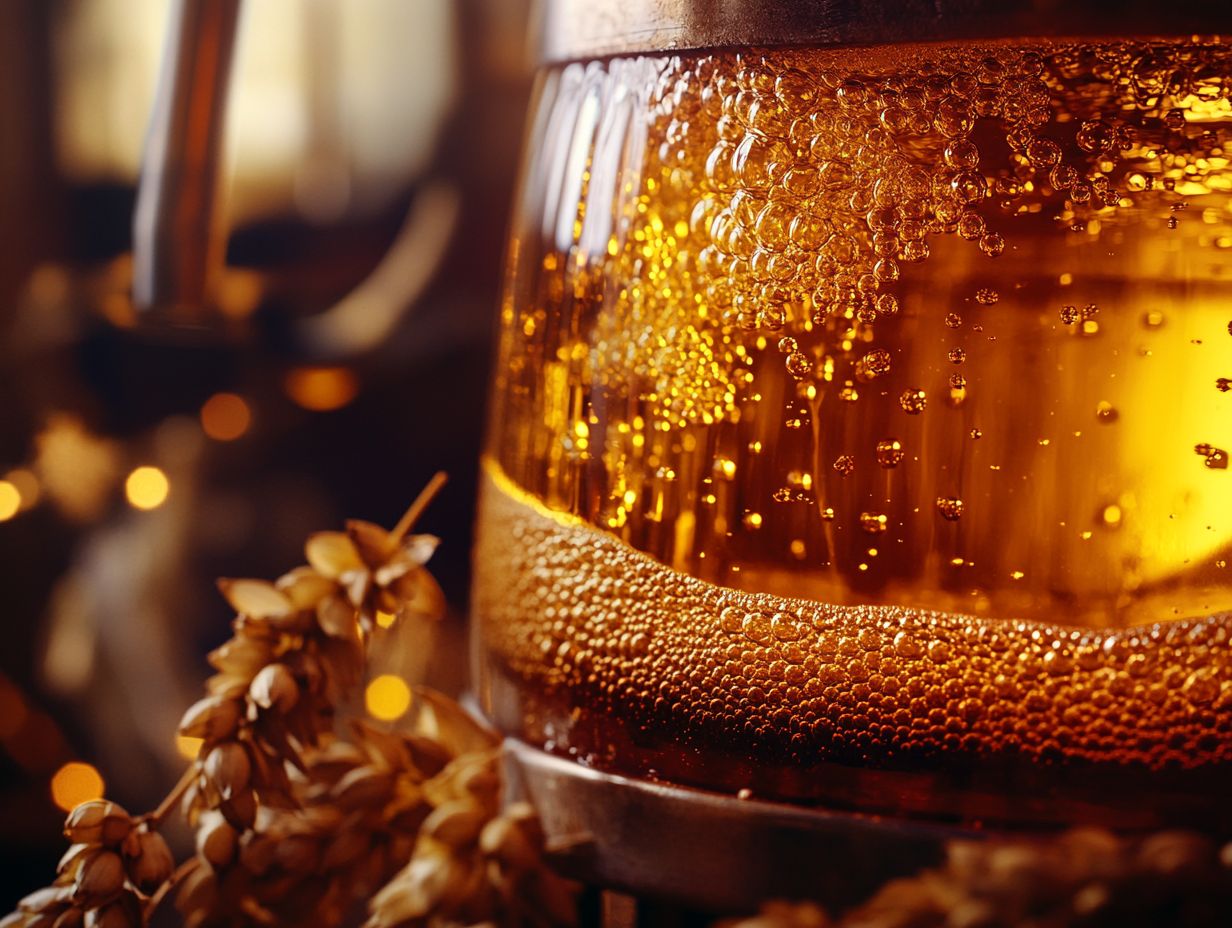
Hops are an essential ingredient in the art of brewing, renowned for their capacity to introduce bitterness, aroma, and flavor compounds that perfectly balance the sweetness of malt and elevate the overall complexity of your beer.
You’ll discover a rich diversity of hop varieties, each boasting unique characteristics that significantly influence the final product. For example, American hops like Cascade and Citra are lauded for their vibrant citrusy and tropical fruit notes, making them a prime choice for IPAs.
In contrast, European varieties such as Saaz and Tettnanger impart delightful herbal and floral qualities, perfectly suited for traditional lagers.
You can strategically use hops at various stages throughout the brewing process. When added early in the boil, they contribute to the beer’s bitterness, while late additions or dry hopping enhance the aroma and flavor. This thoughtful use of hops not only shapes the beer’s taste profile but also plays a crucial role in defining different styles, ultimately influencing your experience as a drinker.
What is the Role of Grains in Brewing?
Grains, with malted barley as the cornerstone, are essential to the brewing process. They provide the crucial wort sugars that yeast will ferment into alcohol and carbon dioxide.
You can also explore a variety of grains, such as wheat, rye, and oats, each bringing distinct characteristics to the final brew. The malting process is a critical step, involving the soaking, germination, and drying of grains to cultivate the enzymes necessary for transforming starches into sugars.
For example, when you use roasted barley, you can infuse your brew with rich flavors and deep colors, while lighter malts might lead to crisp, refreshing pale ales.
The choice of grain not only shapes the beer’s flavor profile and mouthfeel but also connects you to brewing traditions. Certain recipes demand specific grains to achieve authenticity, reflecting the regional styles and historical practices that make brewing such a rich and diverse craft.
The Fermentation Cycle
The fermentation cycle is a crucial element of brewing, comprising several stages that meticulously convert wort into beer. It begins with primary fermentation, transitions into secondary fermentation, and culminates in conditioning. Each stage impacts the fermentation dynamics and the overall fermentation profiles.
Each phase plays an essential role in developing flavor and achieving clarity. This ensures that the final product meets the highest standards of quality.
What Happens During the Primary Fermentation Stage?
During the primary fermentation stage, yeast springs into action, eagerly consuming the sugars from the wort and transforming them into alcohol and carbon dioxide! This process is crucial for shaping the initial character of your beer and involves the high krausen phase, where fermentation activity is most vigorous.
This remarkable conversion not only produces alcohol but also significantly impacts the overall flavor profile and aroma of the final product. Several factors, including the yeast strain, temperature, and oxygen levels, play vital roles in determining how effectively the yeast works. Additionally, the amount of yeast added to the wort, known as pitch rate, is essential for effective fermentation.
For optimal fermentation, maintaining consistent temperatures, known as fermentation temperature control, is essential. Periodically checking the specific gravity, which measures the density of the liquid and indicates how much sugar has been converted, is also important. Monitoring these parameters ensures that fermentation progresses smoothly and helps steer clear of any potential off-flavors or stalled processes that could compromise your beer’s quality.
What Happens During the Secondary Fermentation Stage?
Secondary fermentation plays a pivotal role in allowing your beer to mature and develop greater complexity. It effectively addresses any unwanted fermentation byproducts, like diacetyl, and other fermentation byproducts.
During this phase, the yeast continues its work on leftover sugars, which elevates the overall flavor profile and contributes to the clarity of your brew. Close monitoring of the fermentation process is crucial; it ensures that the yeast performs at its best and provides the opportunity for adjustments if needed.
Employing techniques such as gentle rousing and precise temperature control can significantly influence the conditioning of your beer. By adhering to sound sanitation practices, you can prevent off-flavors and ensure a seamless transition into the packaging phase. Your aim is to deliver a clean and well-balanced product.
What Happens During the Conditioning Stage of the Fermentation Process?
The conditioning stage is the final phase of the fermentation cycle, a pivotal moment where your beer matures. This process allows those intricate flavor compounds to meld and develop while achieving just the right carbonation levels. It also involves a stationary phase where yeast activity slows down.
During this essential period, temperature control is paramount. As a brewer, you need to keep a vigilant eye on the environment to prevent off-flavors and ensure consistency.
A cooler environment tends to slow down the process, enhancing the complexity of your beer’s profile and revealing layers of flavor you might not have anticipated. The length of conditioning time can vary based on what you aim to achieve; some styles flourish with extended aging, while others are best savored fresh.
You will often engage in sensory analysis during this time, tasting your brew to determine when it has reached that perfect balance of flavors, ready to transition into the bottling or kegging stage.
Factors Affecting the Fermentation Cycle
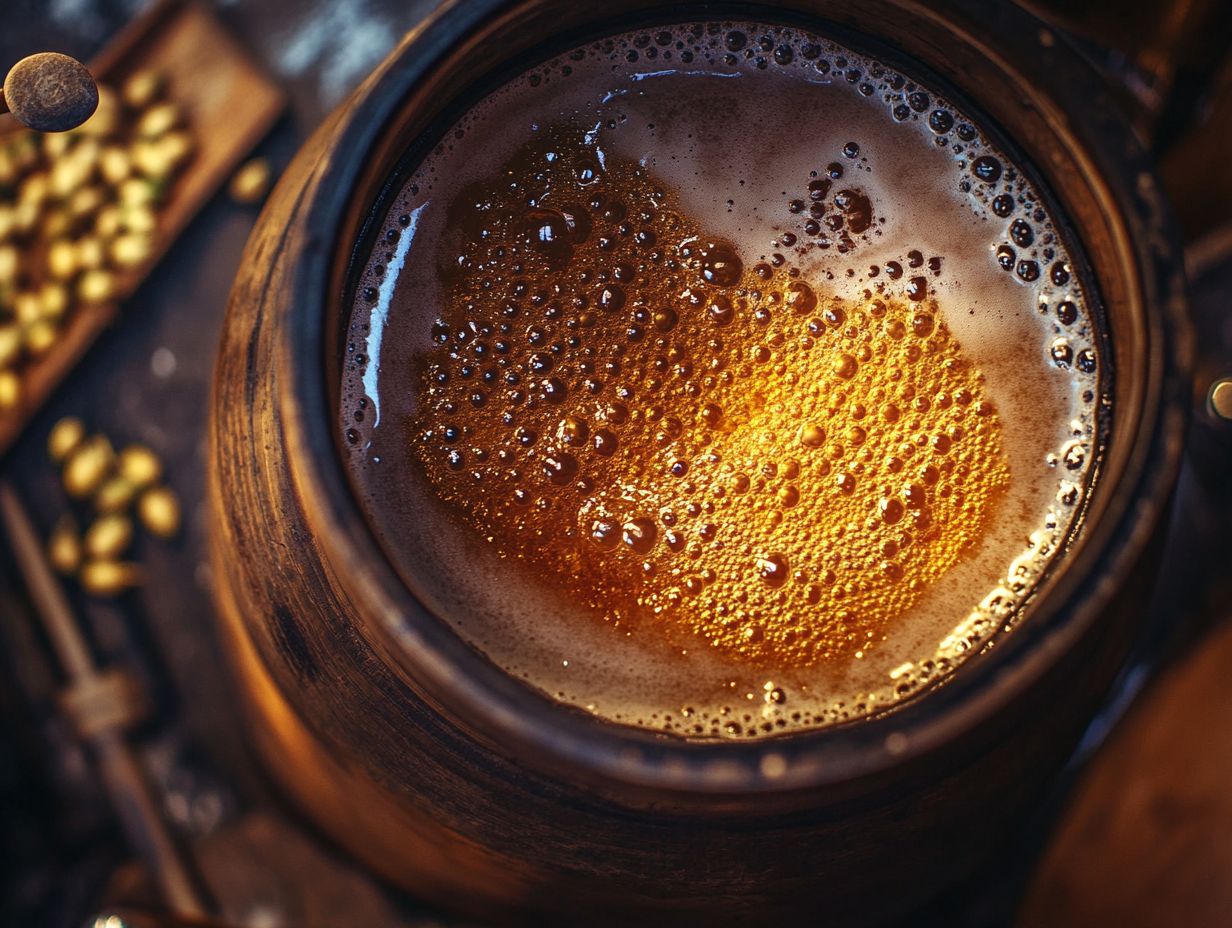
Several critical factors profoundly impact the fermentation cycle, including temperature control, yeast selection, and the specific conditions under which fermentation occurs. Understanding fermentation dynamics and the role of different yeast strains, such as Saccharomyces cerevisiae, is crucial for successful brewing.
Each of these elements can either elevate the fermentation process or impede its progress. Therefore, your attention to detail is essential for optimal results.
What is the Optimal Temperature for Fermentation?
The ideal temperature for fermentation truly hinges on the yeast strain you choose. Typically, ale yeasts flourish in warmer environments, while lager fermentation demands cooler conditions to ensure optimal yeast health and performance. Some yeast strains, like Kveik yeast, can ferment at higher temperatures.
Grasping these temperature dynamics is crucial for you as a brewer. If your goal is to maximize yeast efficiency and craft exceptional beverages, diligently monitoring fermentation temperatures is essential. This means investing in advanced temperature control systems that maintain the perfect conditions for fermentation, leading to a more consistent fermentation profile.
Remember, temperature fluctuations can stress the yeast, impacting their performance and the flavor profile of your final product. Managing temperature is critical for brewing excellence.
How Does the Type of Yeast Affect the Fermentation Cycle?
The type of yeast you choose for fermentation plays a crucial role in shaping the entire fermentation cycle. It affects not just how quickly fermentation occurs, but also the development of unique flavor compounds and the overall profile of your beer.
Yeast strains like Saccharomyces cerevisiae and Kveik yeast offer different fermentation characteristics and attenuation levels. Different yeast strains bring their own distinct characteristics that define the final product. Take Kveik, for instance a traditional Norwegian yeast renowned for its ability to thrive at high temperatures and ferment rapidly. It s known for producing fruity esters and delivering a clean finish.
On the flip side, you have Saccharomyces cerevisiae, the go-to brewing yeast that offers a wide array of flavor profiles depending on the fermentation conditions. This yeast can help you create everything from classic ales to crisp lagers.
The dynamics of fermentation with these yeast strains directly influence the degree to which yeast converts sugar to alcohol. This, in turn, affects the mouthfeel and body of your beer. Mastering these yeast characteristics can elevate your brewing game and help you craft exquisite beer styles.
What is the Role of Oxygen in Fermentation?
Oxygen plays a fascinating dual role in fermentation: it s a friend during the yeast propagation phase, promoting growth, but it quickly turns into a foe during active fermentation. Too much oxygen can lead to off-flavors and compromise the health of the yeast. Effective fermentation monitoring of oxygen levels is essential for maintaining a healthy fermentation process.
To master this delicate balance, you must implement effective oxygen management strategies throughout your brewing process. Proper aeration in the initial stages is crucial for encouraging robust yeast growth, but it s equally important to meticulously control oxygen levels during fermentation.
Techniques like using oxygen-scavenging additives, employing closed fermentation systems, and managing transfers between vessels with care can help you prevent unwanted oxidation. By adhering to these best practices, you can achieve a clean flavor profile and maintain the vitality of your yeast, ultimately enhancing the overall quality of your final beer product.
Common Issues in the Fermentation Cycle
As a brewer, you may often face a range of common challenges during the fermentation cycle. These issues include stuck fermentation, off-flavors, and contamination. Each presents its own set of unique hurdles that can complicate the brewing process.
Tackle these challenges head-on to ensure your brewing journey is a success!
What Causes Stuck Fermentation?
Stuck fermentation occurs when yeast activity unexpectedly halts. This can happen due to less-than-ideal conditions such as weak yeast health, improper temperature control, or an overload of fermentation byproducts.
Poor yeast management and a lack of yeast nutrients can also contribute to this issue. To pinpoint the cause, engage in careful observation and analysis, as multiple factors may be at play.
For example, low yeast cell counts may indicate that your initial pitch rate was insufficient. Additionally, elevated temperatures during active fermentation can stress your yeast.
Diagnosing the problem involves taking specific gravity measurements and tasting your product to identify any off-flavors.
To breathe new life into fermentation, consider adjusting the pitch rate by adding fresh yeast or introducing yeast nutrients that provide the essential compounds your yeast needs for peak performance.
Other effective techniques include gently stirring the fermentation vessel to reintroduce yeast into the active liquid. Adjusting the temperature can also create a more hospitable environment for yeast revival.
What is Off-Flavor in Fermented Beer?
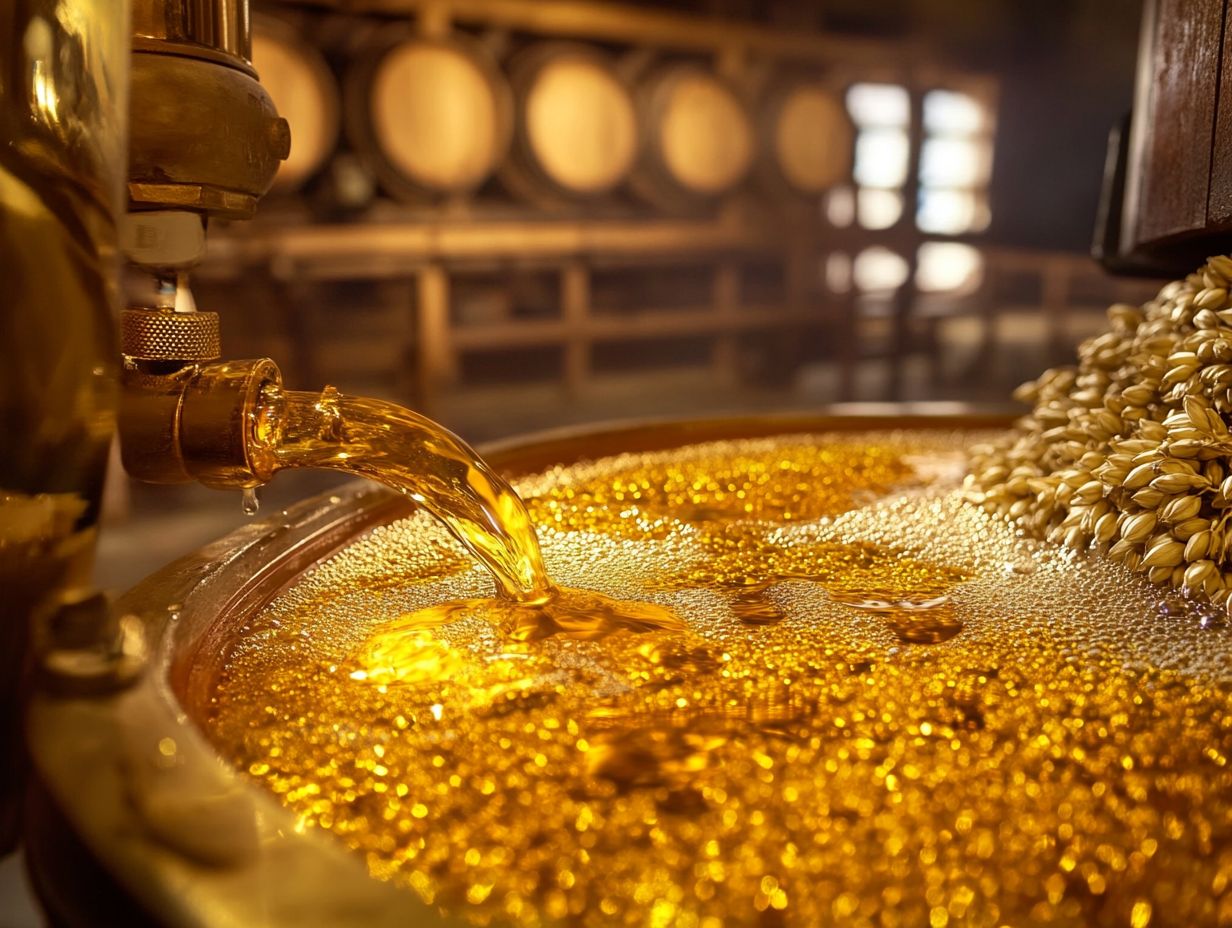
Off-flavors in your fermented beer can emerge from various sources. The fermentation byproduct diacetyl is a prime culprit, often arising from yeast stress or mismanagement during fermentation.
Diacetyl is not the only troublemaker! You may also encounter acetaldehyde, which can give your brew an unwelcome green apple taste, or higher alcohols that contribute a harsh, solvent-like aroma.
These undesirable flavors frequently result from issues like inadequate yeast health, temperature fluctuations, or insufficient oxygen levels during fermentation.
To keep your brew on point, it s crucial to identify these problems through regular sensory evaluations and by closely monitoring fermentation parameters such as temperature, gravity, and yeast viability.
Historical brewing practices emphasize the importance of temperature control and yeast management in preventing off-flavors. To combat off-flavors, adopt proper fermentation techniques.
This includes maintaining optimal yeast pitch rates, ensuring adequate aeration, and controlling fermentation temperatures all essential steps to foster a healthy fermentation process.
How to Prevent Contamination in the Fermentation Process?
Preventing contamination during fermentation is vital for maintaining the quality of your beer. This requires strict adherence to sanitation practices in both your brewing equipment and fermentation vessels.
As a brewer, a clean environment is of utmost importance! Even the tiniest amounts of unwanted microorganisms can disrupt fermentation, resulting in off-flavors and spoilage that no one wants to taste.
To ensure success, effective sanitation techniques are key. Make it a habit to thoroughly clean and sanitize all your brewing tools like fermenters, airlocks, and transfer hoses before and after each use.
Controlling your fermentation environment is equally important. By managing temperature and minimizing air exposure, you significantly reduce the risks of contamination. Consider using Star San or other reliable sanitizers to keep your equipment free from harmful microbes, setting the stage for a successful, clean, and flavorful fermentation.
Frequently Asked Questions
What is the fermentation cycle in brewing?
The fermentation cycle in brewing is the process of converting maltose sugars into alcohol and carbon dioxide using yeast. This critical step in brewing is responsible for creating the final flavor and alcohol content of the beer.
How does yeast (such as Saccharomyces cerevisiae) play a role in the fermentation cycle?
Yeast is a microorganism responsible for fermenting the sugars in the wort (unfermented beer). It consumes the wort sugars and produces alcohol and carbon dioxide as byproducts, giving beer its characteristic flavor and carbonation. Different yeast strains can contribute to various flavor compounds.
What are the fermentation stages in the fermentation cycle?
The fermentation cycle consists of three stages: primary, secondary, and conditioning.
During the primary stage, known as the active phase, the yeast converts most sugars into alcohol.
In the secondary stage, sometimes referred to as the steady phase, the yeast continues to ferment and the flavors of the beer develop.
The conditioning stage is when the beer is left to mature and clarify.
How long does the fermentation cycle typically last in brewing practices?
The length of the fermentation cycle can vary depending on factors such as the type of yeast used, the temperature, and the specific beer recipe.
On average, the fermentation process takes about 2-3 weeks to complete.
Factors like fermentation temperature, oxygen levels, and yeast health also play crucial roles in determining the fermentation duration.
What is the ideal fermentation temperature for brewing different types of ales and lagers?
The ideal temperature for fermentation is typically between 65-75 F (18-24 C).
This range allows the yeast to work efficiently without producing off-flavors.
Different types of yeast have varying temperature needs.
For instance, lager fermentation usually requires lower temperatures.
Therefore, always follow the recommended temperature for the specific type of yeast being used.
What happens if fermentation conditions are not met during the fermentation cycle?
If the fermentation cycle is not done properly, it can lead to off-flavors, a lower alcohol content, or even a spoiled batch of beer.
Issues like improper temperature control, high krausen, or incorrect pitch rate can disrupt fermentation dynamics.
Keep a close eye on the fermentation activity.
Make adjustments as needed to ensure a successful and tasty end result.

